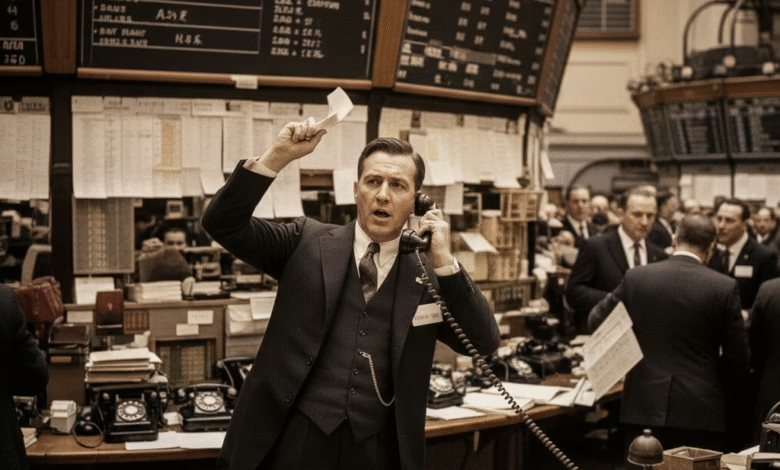How did the stock market work before the internet?
Learn what the financial market was like before the internet

In today’s world, buying a stock is as simple as tapping a button on your smartphone. Within seconds, you can access real-time quotes, execute a trade, and see the shares appear in your online account. The entire U.S. stock market, with all its complexity, is right at our fingertips. But have you ever stopped to wonder how this intricate dance of buying and selling worked before the internet?
Before high-speed data and online brokerages, the stock market was a profoundly physical, human-driven world. It was a place of roaring trading floors, paper stock certificates, and a reliance on a trusted professional—the stockbroker—to connect you to the action. It was a system that functioned on a combination of telephone calls, specialized knowledge, and a whole lot of paper.
This article will take you back in time to explore the fascinating, chaotic, and surprisingly effective mechanics of the pre-digital stock market. Understanding this history not only gives us an appreciation for the technology we have today but also provides valuable insights into the core principles of investing that remain timeless.
The Trading Floor: An Ecosystem of Organized Chaos

At the heart of the pre-internet market was the physical trading floor of an exchange like the New York Stock Exchange (NYSE). Forget quiet offices and computer servers; picture a vast, crowded room buzzing with energy, a sea of people in color-coded jackets shouting, gesturing, and rushing from one post to another. This was the system of open outcry.
Instead of orders being matched by algorithms in a data center, they were executed through face-to-face negotiation. The key players in this ecosystem were:
- Floor Brokers: These individuals were members of the exchange who worked on the trading floor. When a brokerage firm (like Merrill Lynch or Charles Schwab) received a buy or sell order from a client, they would telephone their floor broker. The broker would write the order on a small slip of paper, walk or run to the appropriate trading post for that specific stock, and then execute the trade on behalf of the client.
- The Specialist: At each trading post for a particular stock, there was a designated specialist. The specialist was a market maker whose job was to maintain a fair and orderly market for that stock. They had two primary functions:
- To act as an auctioneer, matching the buy orders from one broker with the sell orders from another.
- To trade for their own account when there was an imbalance of buyers and sellers. If there were far more sellers than buyers, the specialist was obligated to step in and buy shares to stabilize the price and provide liquidity.
This human-based system relied on a complex language of hand signals to communicate buy, sell, price, and quantity information across the noisy floor. It was a high-pressure environment where a broker’s reputation, voice, and ability to think on their feet were their most valuable assets.
Placing a Trade: The Journey of an Order from Main Street to Wall Street
For an average person in the 1980s, buying a stock was a deliberate and multi-step process that could take a significant amount of time. There was no instant gratification.
Here’s what the journey of a single trade looked like:
- The Phone Call to Your Broker: The process started with a phone call to your personal stockbroker. You couldn’t just log into an app. You had a relationship with a specific individual at a brokerage firm. You would tell them, “I’d like to buy 100 shares of IBM at the market price.”
- The Order Ticket: Your broker would write your order down on a physical “order ticket,” noting the stock, the quantity, and the order type (e.g., market or limit).
- Relaying the Order to the Floor: The order ticket would then be given to a clerk in the “wire room” of the brokerage. This clerk would telegraph or telephone the order down to the firm’s booth on the floor of the stock exchange.
- Execution on the Floor: A floor clerk at the booth would receive the order and hand it to a floor broker. The floor broker would then hustle over to the specialist’s post for IBM and execute the trade using the open outcry system, finding a seller at the best available price.
- Confirmation: Once the trade was executed, the process worked in reverse. The floor broker would confirm the price on the order slip, which would be relayed back to the brokerage office, and finally, your broker would call you back to confirm, “We’ve bought 100 shares of IBM for you at $75.50.”
This entire process could take several minutes or longer, during which time the stock’s price could have changed. The idea of getting a sub-second execution was pure science fiction.
Information and Research: The Age of Print and Patience
Today, we are drowning in financial information. We have instant access to earnings reports, analyst ratings, and up-to-the-second news. Before the internet, obtaining this information required effort, money, and, most of all, patience.
- The Wall Street Journal and Newspapers: For most people, the primary source of financial news and stock prices was the daily newspaper. You would open The Wall Street Journal or the business section of your local paper to see yesterday’s closing prices, printed in tiny font in massive stock tables.
- Company Annual Reports: To do a deep dive on a company, you had to call or write to their investor relations department and ask them to mail you a physical copy of their annual report. This glossy booklet contained the financial statements and management’s discussion—information that would arrive weeks or months after the fiscal year had ended.
- Value Line and Moody’s: Serious investors subscribed to services like the Value Line Investment Survey. This was a thick binder, delivered weekly by mail, containing one-page tear sheets on hundreds of companies, with charts, financial data, and analyst commentary. It was one of the most comprehensive and respected sources of research available to individual investors.
- Your Broker’s Research: A key value proposition of a full-service stockbroker was providing you with their firm’s proprietary research reports on various companies and industries. This created a significant information advantage for clients of large, well-resourced firms.
The key takeaway is that information was slow to disseminate and often expensive to obtain, creating a significant gap between professional Wall Street insiders and the average retail investor.
Stock Quotes and Market Data: The Ticker Tape and the Evening News

How did people track the market during the day? Real-time quotes were a luxury. Most people relied on delayed information.
- The Ticker Tape: The iconic ticker tape machine was a marvel of its time, printing a continuous stream of stock symbols and prices on a thin ribbon of paper. However, these machines were typically found only in brokerage offices and wealthy private clubs. Even then, the “ticker” was often running 15-20 minutes behind the actual trading on the floor.
- Quotron Machines: By the 1960s and through the 80s, dedicated desktop terminals like the Quotron became common in brokerage offices. These bulky, green-screened machines provided more up-to-date quotes but were still a professional tool, not something found in the home.
- The Evening News: For the vast majority of the public, the main market update came from the evening news broadcast. A news anchor would spend 30 seconds summarizing the day, stating the closing value of the Dow Jones Industrial Average and whether it was up or down.
Clearing and Settlement: The Mountain of Paperwork
Perhaps the most mind-boggling aspect of the pre-internet market was the back-office process of clearing and settlement. Today, this is an entirely digital and automated process. Back then, it was a logistical nightmare.
When you bought a stock, you were buying a physical stock certificate. This was an ornate, beautifully printed piece of paper that served as legal proof of your ownership.
After a trade was executed, an army of clerks in the back offices of brokerage firms had to manually process the transaction. This involved matching trade tickets and preparing the physical certificates for transfer. Armored cars would shuttle mountains of these certificates between brokerages and clearinghouses in lower Manhattan every day.
This paper-based system was pushed to its breaking point in the late 1960s during a period of high trading volume. The sheer volume of paperwork became so overwhelming that the NYSE had to close every Wednesday just to allow firms to catch up. This “Paperwork Crisis” was a major catalyst for the adoption of early computer systems to begin digitizing records and streamlining the settlement process.
The Digital Revolution: How Everything Changed
The advent of the internet and digital technology didn’t just speed up the old system; it fundamentally re-engineered it.
- Democratization of Access: Online brokerages cut out the middleman, allowing anyone to place a trade directly and instantly.
- Collapse of Commissions: Trading costs plummeted from over $100 per trade at a full-service broker to zero at many online firms today.
- Information Parity: Company reports, real-time news, and market data became free and instantly available to everyone, leveling the playing field between retail and institutional investors.
- Rise of Electronic Trading: The noisy trading floors and open outcry systems were largely replaced by silent, powerful servers that can execute millions of trades per second.

Looking back at the clunky, paper-intensive, and human-centric market of the past gives us a profound appreciation for the efficiency and accessibility we enjoy today. While the technology has changed beyond recognition, the fundamental principles of buying and selling ownership in great businesses remain exactly the same.




